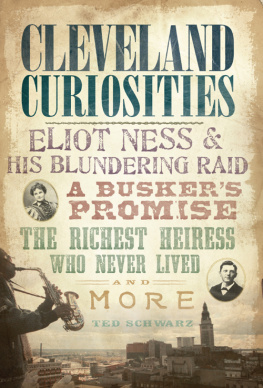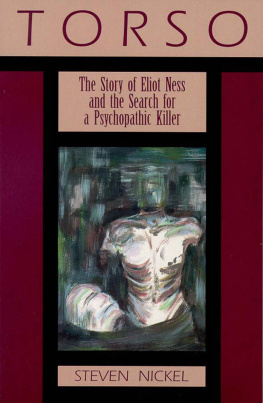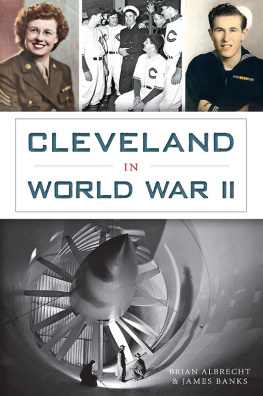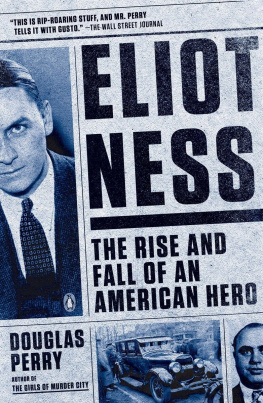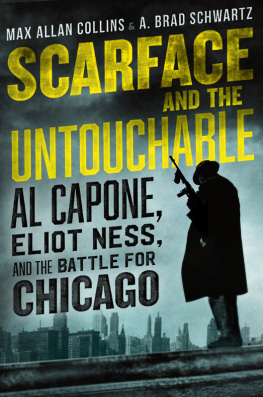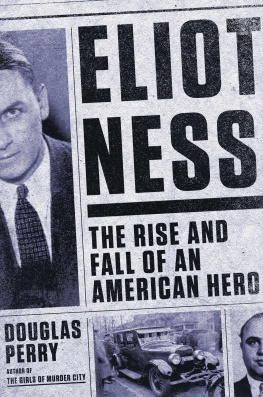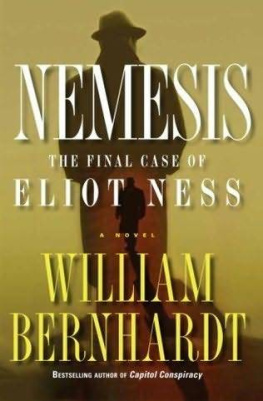Published by The History Press
Charleston, SC 29403
www.historypress.net
Copyright 2010 by Ted Schwarz
All rights reserved
Front cover: Courtesy of Cleveland State University Press Collection and
Cleveland Public Library Photograph Collection.
Front cover, bottom: Photo by the author.
First published 2010
e-book edition 2011
ISBN 978.1.61423.252.0
Library of Congress Cataloging-in-Publication Data
Schwarz, Ted, 1945-
Cleveland curiosities : Eliot Ness and his blundering raid, a buskers promise, the richest heiress who never lived, and more / Ted Schwarz.
p. cm.
print edition ISBN 978-1-59629-919-1
1. Cleveland (Ohio)--Biography--Anecdotes. 2. Celebrities--Ohio--Cleveland--Biography--Anecdotes. 3. Curiosities and wonders--Ohio--Cleveland--Anecdotes. 4. Cleveland (Ohio)--History--Anecdotes. 5. Cleveland (Ohio)--Social life and customs--Anecdotes. I. Title.
F499.C653A28 2010
977.132--dc22
2010042768
Notice: The information in this book is true and complete to the best of our knowledge. It is offered without guarantee on the part of the author or The History Press. The author and The History Press disclaim all liability in connection with the use of this book.
All rights reserved. No part of this book may be reproduced or transmitted in any form whatsoever without prior written permission from the publisher except in the case of brief quotations embodied in critical articles and reviews.
Contents
Eliot Ness? You Just
Thought You Knew Him
You can get more with a kind word and a gun than you can with a kind word alone.
Quote from Chicagos notorious bootlegger, brothel operator and all-around bad guy Al Capone
Gossip is the art of saying nothing in a way that leaves practically nothing unsaid.
Walter Winchell
I usually get my stuff from people who promised somebody else that they would keep it a secret.
Walter Winchell
Gossip columnist Walter Winchell and former Cleveland public safety director Eliot Ness were two men on the downward slope of fame. Walter Winchell was not the first gossip columnist in America, but in the preWorld War II years, he was arguably the hardest working and most influential. He knew everyone and celebrated everyone, so long as their names in print could generate office gossip the day they appeared. Owen Owney the Killer Madden, a mob guy and the rare individual who left the rackets alive to retire on a substantial holding of ill-gotten gains, was a friend and subject. Likewise, FBI Director J. Edgar Hoover considered Winchell a friend because the newsman deliberately wrote laudatory column items about him.
Winchell was heard on radio. He was read in newspapers from coast to coast, a fact that inspired other media giants to hire their own personnel. Louella Parsons and Hedda Hopper, Syd Skolsky and Earl Wilson, Ed Sullivan and Jim Bacon all were getting their turns. As a result, the attention Winchell once commanded was being dissipated in the 1950s. His income was down to where he needed to find someone who would be exclusively his and renew his columns must-read cachet. The answer was a dead man.
Two decades earlier, when Eliot Ness was head of the U.S. Treasury Departments alcohol tax units get-Capone squad, he became the best-known lawman in America by being the first to have a comic strip based on fantasies about his exploits. Not that the Ness name was used. Cartoonist Chester Gould, the comic strip artist and writer, called his version of Ness Dick Tracy, but Ness, Hoover and Winchell knew the truth, and it infuriated Hoover. It also helped refine the myth of Nesss career in Chicago before he came to Cleveland.
Ness, born in Chicago in 1903, graduated from the University of Chicago in 1925, near the end of Prohibition. His classes were mostly business related, and it would be as a businessman at the end of the Prohibition era that Al Capone was eventually jailed.
Capone was a bootlegger who also operated a nationwide delivery service for other bootleggers needing their liquor shipped from where it was either manufactured or smuggled into the United States. He ran gambling operations. He engaged in extortion. And because of youthful indiscretions with willing young women, he had syphilis, which had gone untreated for so many years that it was essentially a death sentence waiting to happen. It also made Capone extremely volatilethe reason so many of his enemies were killed in unusually brutal ways. But despite the image of Ness and the men who worked with him as being incorruptibleUntouchables, they were called, because they rejected all bribesthe dangers they faced in their pursuit of Capone were limited. Violent shootouts, car chases and the like; a mainstay of books about Capone and Ness; a television show based on Nesss self-serving autobiography; and at least one motion picture did not happen. Al Capone was brought to justice because he was too cheap and too greedy to pay taxes.
Capone, who obviously lived well, could have declared income that matched his lifestyle, paid taxes accordingly and kept the difference between what was reported and what was paid. Instead, he thought he was being smart by keeping it all and paying nothing, never realizing that under the law he was showing himself to be indigent. A man with no visible means of support and claiming none was considered a vagrant and could be jailed as such. This was the justification for the arrest of Capone, giving the federal officers time to build a case for income tax evasion. Capone was convicted and sent to prison, where his health deteriorated due to syphilis. After being paroled from prison, Capone died in seclusion at his home in Palm Beach, Florida, of a stroke followed by pneumonia.
The public eventually came to believe the myth that Capone met Ness, presumably the tougher of the two men, in a violent showdown and that the conviction was based on Capones violent criminal empire. In truth, Ness and the other federal officers had no blazing firefights with Capone with Thompson submachine guns (Tommy guns), no close combat with handguns and no hand-to-hand combat (though Ness was a judo practitioner). And Capones brothels, bootlegging and gambling joints continued business almost as usual under the direction of hand-picked Capone subordinates.
(About fifteen years following Nesss death, the last survivor of the Untouchable agents was teaching police academy classes as part of his job with the division of Alcohol, Tobacco and Firearms. He told the officers about the work they did with Ness in Chicago and Cleveland, laughing about the fact that when five oclock came around, they often went drinking. They knew where to get the best Prohibition-era liquor.)
Ness might never have come to the attention of Clevelands civic leaders if it hadnt been for what could be called the cult of Al Capone. Writers from around the world were fascinated with the idea of American gangsters in general and Capone in particular. He was an expert at creating short, amusing quips that were quoted by columnists and repeated by office workers and others. He also had a number of biographers, most of whom had never met him, had never met anyone who knew him and, in some cases, had never been to the United States.
Typical was author Jack Bilbos autobiography,

